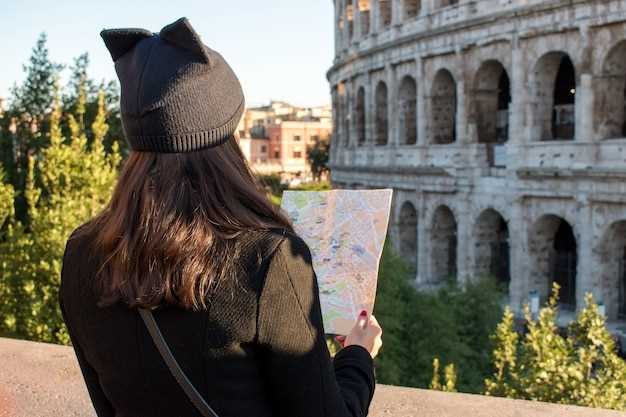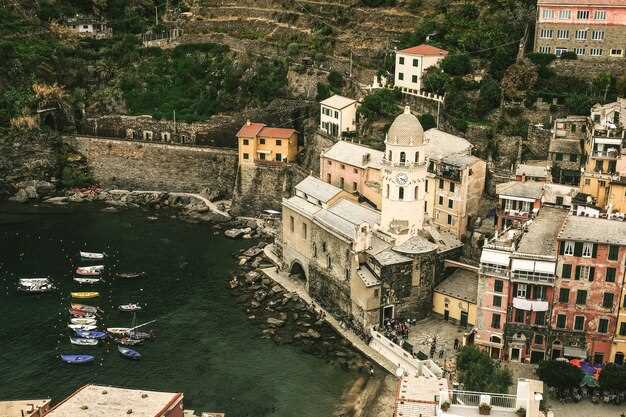
Begin with a two-week route that clusters Rome’s Historic Centre, a southern Sicily detour, and a northern coast arc to spread crowds and optimize light. This focused plan centers on renowned sites while leaving space for أصيل discoveries and adventures in lesser-known corners.
Across Lazio, Campania, Veneto, Liguria, Tuscany, Sicily, and Basilicata, the 15 sites span grand forums, cliffside towns, and a lush hillside settlement. Allocate about two to four hours for major complexes like the Colosseum or Pompeii, and stop longer along the Ligurian coast or in Venice to wander towns and markets. A night in a villa adds a comforting layer to the itinerary and offers a chance to watch the travel day close with a sunset over vineyards or the sea.
Early starts help beat crowds and reveal quieter corners. In each region, grab a plan that blends towns with a few adventures off the main routes, from a morning stroll through a medieval street to a coastal cliff hike for a distinct travel activity.
In the north, the Leaning Tower of Pisa tilts gracefully, a renowned landmark that frames a day of perspectives on architecture and life around towns. In the south, Matera and Cefalù reveal how settlement patterns shaped daily routines and social life. Each site provides stories and photo-worthy vistas that enrich your guide and keep the itinerary full of moments.
With this structure you can balance culture and scenery and achieve a pace that suits you. Start with two anchors, then add a southern loop or coastal arc to expand your list of adventures. The plan can provide flexibility for last-minute changes, letting you linger in a market, enjoy a villa stay, and choose a activity near the water or a village.
7 Piazza del Duomo Pisa More Than the Leaning Tower
Buy the combined ticket to access the Cathedral, Baptistery, Camposanto, and Opera del Duomo Museum. The carved marble facades and the pulpit by Nicola Pisano reveal Pisa’s medieval artistry. Experts note the complex is located in the heart of Pisa, near the Arno, in the country of Italy, Europe.
This setting feels like a fairytale, where royalty and faith shaped design across centuries. The Baptistery’s acoustics and the Camposanto’s frescoes offer an intimate look at Tuscan life. Beyond the Leaning Tower, the complex acts as extensive cultural centers that attract tourists. For a bite, explore the nearby culinary spots offering biscotti, pasta, gelato, and Tuscan wines. Suddenly, bells echo as the day shifts over the square.
Plan an overnight stay in Florence and take a morning train to Pisa; the route is short and efficient. The ride passes vineyards and hill towns and has ever attracted curious travelers.
Extend your itinerary to contrast with cerveteri’s ancient necropolises and with herculaneum’s legendary ruins, showing Italy’s breadth of heritage. The experience here blends monumental stone with intimate courtyards, offering a program that feels timeless.
When you arrive, book ahead, beat crowds by visiting early, and reserve time to climb the Leaning Tower after seeing the cathedral interior. Suddenly, bells ring and the square fills with light. The Opera del Duomo Museum houses chronicles of Pisa and famous works, while nearby streets invite casual strolls and reflections on Europe’s artful past.
Pisa: Beyond the Leaning Tower – Piazza del Duomo highlights: cathedral, baptistery, Camposanto, and ticket order

Begin your visit with a focused plan: buy a combined ticket online for the Cathedral, Baptistery, Camposanto, and Museo dell’Opera del Duomo, then enter the Cathedral first to hold the space and absorb the design before the crowds grow. The Leaning Tower sits nearby as a separate ticket, so set aside a dedicated slot if you want to climb, and allocate two to three hours in total to enjoy the ensemble without rush.
The Cathedral (Santa Maria Assunta) stands as the centerpiece, its exterior a confident blend of Romanesque lines and slender windows that hint at centuries of artistry. Inside, the grandeur comes from the careful rhythm of arches, stonework, and a pulpit whose drawing and sculpture reveal celebrated craftsmanship. Your eyes will travel along the nave to the gilded ceiling and the marble altar, while the soft light through the windows creates dotted patterns on the floors–an easy way to appreciate the museum-worthy design without feeling crowded.
The Baptistery follows with its circular plan and thick walls that hold a distinct acoustical warmth. Climb to the gallery to view the arcaded exterior and then step into the interior, where light pours through high windows, transforming the space into a living sculpture. The ambiance lends a familiar warmth, and the acoustics invite a quiet test of your own voice–perfect for a brief moment of reflection before moving on to the Camposanto.
The Camposanto Monumentale invites contemplation of burial and memory, built beside terraced earth that holds historic frescoes and stone pathways. The fresco cycles and architectural details reveal an artistry that has been celebrated for generations. In the shade of the cloister-like corridors, you’ll notice arches that echo like an ancient amphitheater, offering a sense of continuity between past days and today’s sightseeing. The room layouts and the painted narratives provide a scenic backdrop for taking in the plaza’s view beyond the windows toward the surrounding rione and coastlines.
Ticket order tip: reserve an online slot for each site in a logical sequence–Cathedral first, Baptistery second, Camposanto third–then add the Museo dell’ Opera del Duomo if you want deeper context on the design and sculpture. Present your QR code or confirmation at the door, follow posted signage, and keep your ticket handy; staff will guide you to the next venue. If you also plan a visit to the Leaning Tower, purchase that slot separately and align it with your time in Piazza dei Miracoli; the different sites sit on the same coast road and are easy to reach by walking from the train station or using local transportation options.
Outside, the piazza offers a scenic panorama: the cathedral spires rise over the Arno valley’s edge, while the surrounding pastures and hillside farms frame the coast in views that feel both distant and intimate. The experience remains at once familiar and celebrated, a compact showcase of Tuscan design and artistry that highlights not just the tower but the whole rione–each element contributing to a cohesive sense of place that locals hold dear and visitors want to revisit.”
Plan an efficient UNESCO circuit: a practical route across Italy
Begin in Rome’s historic center, allocating two days to see sights such as the pantheon, the Trevi Fountain, and other markers; book a central hotel to minimize transit, then take a fast train outside the city to Tivoli for hadrians Villa.
From Tivoli, head outside the city to Pompeii and Herculaneum; the furore around these spots is astonishing, and visiting early helps avoid crowds; the spring or autumn climate makes the walk comfortable; book a combined ticket to save time.
Next, travel north to the Dolomites; base in Bolzano or Cortina for 3–4 days; the glacial peaks and innovative lifts offer awe-inspiring scenery; let aeolus guide the wind as you switch from high trails to relaxed walks; check the weather and pack layers.
Return south along major centers and spots such as Verona or Venice or end in Rome; this route brings many itineraries together and avoids backtracking; book rail passes to streamline transitions and keep the plan flexible for changing conditions.
| اليوم | Route & UNESCO sites | Notes |
| Day 1–2 | Rome: Historic Centre – pantheon, Trevi Fountain, other sights | Stay central; use short transfers |
| اليوم الثالث | Rome → Tivoli: Hadrians Villa | Train ~1h; pre-book tickets |
| Day 4–5 | Tivoli → Pompeii & Herculaneum | Naples line; buy a combined ticket |
| Day 6–7 | Dolomites: Bolzano / Cortina (glacial zones) | Cable cars; weather checks |
| Day 8 | Return south via Verona or Venice | Rail connections; end in Rome or continue elsewhere |
Ticketing, passes, and timed-entry: save time at major sites
Always book online timed-entry two weeks in advance for the largest listed sites, then lock in early slots to minimize crowds.
- Online tickets unlock specific time windows. Reserve a morning slot whenever possible, and plan to arrive 20–30 minutes early to clear security without rushing.
- Passes and bundles save waiting time across multiple sites. If you specialize in art or history, compare a strategic multi-site option with individual tickets to see which offers real time savings for your itinerary.
- Use mobile tickets or printed confirmations stored on your phone to speed entry. Some venues require you to scan a code at the gate; have battery backup or a printed backup just in case.
- Choose early or late-day slots in popular weeks. Weekdays tend to be calmer than weekends, and sessions outside peak hours reduce delays caused by tour groups.
- Pre-plan transitions between sites placed along a logical route. A strategic sequence cuts down travel time and lets you enjoy the environment rather than rush through halls, corridors, and courtyards.
Inspired by centuries of preservation, the best approach combines smart booking with a personal plan. If you yourself plan to visit Florence, Rome, or Naples, a little prep pays back with great momentum and a pleasant pace. The largest sites reward early attention: you can photograph soaring ceilings, admire craftsmanship in meticulous frescoes, and move through serene residential streets without the crush of crowds.
Important practical notes for first-time visitors: verify that your pass remains valid across the dates you intend to visit, especially when you plan to connect cities by rail. A cross-city, cross-site itinerary benefits from a single, consolidated ticket or pass rather than buying separate entries at each stop. For sites with scientific or archaeological significance, show patience for security checks and follow posted timings to avoid missing your window.
To maximize efficiency, build a tight, yet flexible, schedule around the following realities. Early slots at the largest venues often sell out first; after you secure them, slot secondary sites nearby to reduce travel time. In regions with valleys and colline–think Tuscan hills and Umbrian slopes–you can combine a day of exploration with light outdoor pauses, turning a potentially exhausting day into a pleasant, balanced adventure for yourself and your companions.
- Best-practice timing: book the earliest available slot for flagship sites, then fill later slots with smaller, nearby museums or gardens to maintain momentum throughout the day.
- Access accessibility: some venues require separate queues for accessibility services. If needed, check ahead for assisted-entry options and reserve them with your primary ticket.
- Location logic: cluster sites by geography to avoid backtracking. For example, a day around Rome can pair the Colosseum with the Forum and Palatine, followed by a short transit to the Vatican for a timed-entry window.
- Seasonal hint: summer crowds peak from June through August; plan spring or fall visits when weather is pleasant and lines are shorter.
For a practical, value-driven approach, consider this suggested sequence. Start with an early slot at the largest site, then visit adjacent halls or galleries that require shorter internal routes. If your schedule allows, follow with a midday break at a nearby café or farmers market to recharge before your next timed-entry. This rhythm keeps your energy steady and your experience more than just a checklist–it’s an adventure that blends history, landscape, and culture with a smooth pace.
When you arrive at a site like Santa Croce or other croce-linked locations, arrive prepared with photo IDs, relevant passes, and a backup plan in case a preferred time is sold out. A well-coordinated plan gives you a great feeling of control and freedom, turning a potentially exhausting day into a constructive, inspiring experience. Remember: early bookings, strategic passes, and a focused route are your best tools for turning a crowded visit into a memorable, efficient one that respects both the site and its visitors.
Finish with a quick reflection: if you’re visiting multiple UNESCO sites across Italy, a thoughtfully mapped itinerary helps you savor the craftsmanship, the soaring arches, and the quiet colline views without compromising safety or comfort. You’ll leave inspired, knowing you planned yourself into a successful, respectful, and enjoyable exploration of Italy’s rich heritage.
Best times to visit: weather, crowds, and local events

Visit in late spring (April–May) or early autumn (September–October) for the ideal balance of climate, lighter crowds, and vibrant local events.
The spring climate brings mild days, roughly 15–22°C on most plains, with mountain routes opening gradually and wildflowers brightening hill towns. This is an excellent window for hiking and exploring refined towns without the heat that hits inland sites later in the year.
Summer brings the highest crowds and warmer conditions, especially along the coast and near major ruins. Plan to start visits at dawn, allocate afternoons to shaded terraces, and reserve time for indoor attractions like libraries or museums when interiors are cooler.
Autumn delivers steady temperatures and fewer queues, with harvest festivals adding color to many towns. In October you’ll find comfortable days for long strolls along cammini and main promenades, and evenings stay pleasantly temperate for strolls after dinner.
Winter appeals to higher-altitude sites where temperatures drop but scenery remains dramatic. If you ski or roam mountain terrain, use the cooler months for day trips to nearby slopes, then switch to city culture in valleys and towns with milder microclimates.
Local events shape each season: Venice’s Carnevale and Siena’s Palio in summer create lively crowds, while spring markets and autumn fairs celebrate local produce. If you time visits to coincide with a festival, you gain a vivid sense of civilization’s living traditions, as crowds ebb and flow around historic walls, piazzas, and public libraries that showcase centuries of created culture.
To plan efficiently, target eight practical windows across the year: spring and autumn offer gentle climates and fewer crowds, while winter and early summer provide quiet moments and specialized experiences like hiking in mountain settings or skiing nearby peaks. Where you base yourself, a refined town near the main routes helps you minimize transit time and maximize immersion in endemic landscapes and local customs. In sites with grand architecture, the largest monuments–created by visionary builders–reward early visits before the day’s heat or crowds arrive, without sacrificing access to hidden corners and quiet courtyards behind time-worn walls.
Logistics and accessibility: transit options, parking, and mobility tips near world heritage sites
Plan rail-first and stay near major stations to minimize transfers. Trains connect the capital city hubs with many UNESCO destinations, letting travelers discover multiple sites in one trip. Buy regional and high‑speed tickets in advance, and map park‑and‑ride options outside crowded centres to keep travel efficient and affordable.
Venice relies on canals rather than roads, so a multi‑day vaporetto pass provides value and flexibility for exploring the celebrated centre and its adjoining areas. Park at Tronchetto or Piazzale Roma, then reach the centre by waterbus or on foot. Awe‑inspiring views unfold as you move between the grand palazzi and the grand canal, making it easy to fall in love with the city’s design and urban rhythm.
Cinque Terre remains car‑free outside La Spezia, with frequent regional trains connecting the five villages and linking to Pisa and Genoa. Use the trail between villages to experience the coast firsthand, and buy a Cinque Terre Card for unlimited rides on the local network. The afternoon light over the coast is ideal for photography, but prepare for sun and breeze along the path.
Pompeii is car‑friendly for parking at Parcheggio Scavi di Pompei, with easy train connections from Napoli Centrale on the Circumvesuviana. From the stop, a short walk leads you into the ruins and onto the preserved streets where ancient life comes alive. This combination of transit and ruins provides a practical rhythm for travelers who want to combine culture and convenient access.
From Catania, Circumetnea railway services the etnas foothills, with a later cable lift from Rifugio Sapienza to the crater area. Plan a circular day that starts with a train ride and ends with a hillside trail above lava landscapes, offering a climate contrast between valley floors and high elevations. The etnas region delivers an awe‑inspiring activity for nature lovers and keeps you close to Sicily’s diverse scenery.
Pisa remains a celebrated destination for its Leaning Tower, where trains from Florence reach Pisa Centrale in about an hour. Parking options near the station are straightforward, and a stroll through the square reveals the cathedral and baptistery’s intricate design. If you stay in a casa near the station, you’ll maximize time for a quick visit before heading to another destination by rail.
